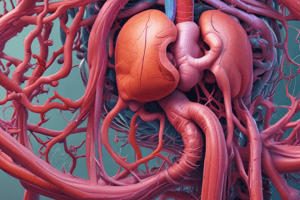Podcast
Questions and Answers
Which enzyme is responsible for breaking down maltose into glucose?
Which enzyme is responsible for breaking down maltose into glucose?
- Maltase (correct)
- Lactase
- Lipase
- Amylase
What is the main function of lipase in the digestive system?
What is the main function of lipase in the digestive system?
- Convert lactose into glucose and galactose
- Break down proteins into amino acids
- Break down fats into fatty acids and glycerol (correct)
- Convert sucrose into fructose and glucose
Which enzyme breaks down lactose into glucose and galactose?
Which enzyme breaks down lactose into glucose and galactose?
- Proteases
- Amylase
- Sucrase
- Lactase (correct)
In which part of the body is sucrase secreted?
In which part of the body is sucrase secreted?
Which enzyme is important for digesting proteins into amino acids?
Which enzyme is important for digesting proteins into amino acids?
What is the primary function of amylase in the digestive process?
What is the primary function of amylase in the digestive process?
The enzyme lactase primarily acts on which sugar?
The enzyme lactase primarily acts on which sugar?
Which enzyme is produced in small amounts by the mouth and stomach?
Which enzyme is produced in small amounts by the mouth and stomach?
Study Notes
Digestive System Organs
- Salivary glands produce saliva, which lubricates the mouth and throat, helps swallow and digest food, and protects teeth from bacteria that cause cavities.
- The esophagus is a muscular tube that carries food and liquid from the throat to the stomach.
- The liver controls chemical levels in the blood, produces bile to remove waste, and processes blood from the stomach and intestines.
- The stomach is a J-shaped organ that digests food using enzymes and acids.
- The gallbladder stores and concentrates bile made by the liver, which helps digest fat.
- The pancreas is a gland located in the upper left part of the abdomen, behind the stomach, and plays a vital role in digestion and blood sugar regulation.
- The large intestine, also known as the colon, is the last part of the digestive system, and its main job is to absorb water and electrolytes from the food and to form stool.
- The small intestine is a long, narrow tube-shaped organ that absorbs nutrients from the food.
- The appendix is a small, finger-shaped pouch of tissue that protrudes from the large intestine.
Digestive Process
- The brain signals the muscles of the esophagus, and peristalsis begins, allowing food to pass into the stomach.
- The stomach muscles mix the food and liquid with digestive juices, and the stomach slowly empties its contents into the small intestine.
- The muscles of the small intestine mix food with digestive juices from the pancreas, liver, and intestine, and push the mixture forward for further digestion.
- The walls of the small intestine absorb water and the digested nutrients into the bloodstream.
- Waste products from the digestive process move into the large intestine, where water is absorbed and changed into stool.
- Peristalsis helps move the stool into the rectum, where it is stored until it is pushed out of the anus during a bowel movement.
Excretion
- Excretion is the elimination of indigestible substances and waste products from the body, primarily involving the expulsion of feces.
- Feces are formed in the large intestine through the absorption of water and electrolytes from the remaining chyme.
- Once formed, feces are propelled towards the rectum and eventually expelled through the anus during defecation.
Digestive Enzymes
- Digestive enzymes are substances that help digest food by splitting large, complex molecules into smaller ones.
- Digestive enzymes are released when we anticipate eating, smell and taste food, and go through the digestive process.
- Types of digestive enzymes include:
- Amylase, which breaks down starches into sugars.
- Maltase, which breaks down maltose into glucose.
- Lactase, which breaks down lactose into glucose and galactose.
- Lipase, which breaks down fats into fatty acids and glycerol.
- Proteases, which break down proteins into amino acids.
- Sucrase, which breaks down sucrose into fructose and glucose.
- Digestive enzyme deficiencies can occur due to various health conditions, including inherited genetic conditions and those that develop over time.
Studying That Suits You
Use AI to generate personalized quizzes and flashcards to suit your learning preferences.
Description
This quiz covers various parts of the human digestive system, including the salivary glands, esophagus, and liver, along with their functions in the digestion process. Test your knowledge on how these organs work together to help you digest food effectively.




